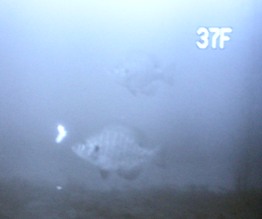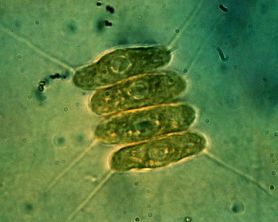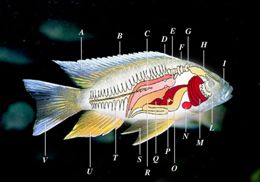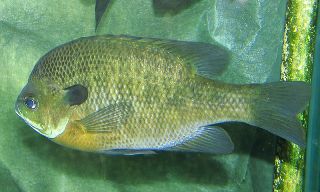Navigation
Eating Across Phyla
Temporal Influences on Bluegill Nutrition
Bluegills use strong sensory structures to
identify possible prey items. These
structures are discussed thoroughly in the
adaptation section.  Once
they have identified that an organism is edible, bluegills use
gill rakers and bands of teeth to suck in their food.
During summer months, bluegills generally consume up to 35% of
their body weight on a weekly basis (Spotte,
2007). On the other hand, this rate drops to 1% over winter
because food sources are not readily available
(Spotte, 2007). As omnivores, bluegills
consume a wide variety of both plants and animals.
Once
they have identified that an organism is edible, bluegills use
gill rakers and bands of teeth to suck in their food.
During summer months, bluegills generally consume up to 35% of
their body weight on a weekly basis (Spotte,
2007). On the other hand, this rate drops to 1% over winter
because food sources are not readily available
(Spotte, 2007). As omnivores, bluegills
consume a wide variety of both plants and animals.
| Bluegills Feeding in Chilly Mississippi Water (Image taken by Author) |
Nutrition of a Juvenile Bluegill
While hiding from predators in weed beds, juvenile bluegills
feed on algae and zooplankton. Eventually, they
leave the weed beds to feed on a wider variety of flora
and fauna. This allows them to negate competition
with other fish species that stay within the thick aquatic cover.
At maturity, bluegills consume aquatic insects, small fish
(such as the
common shiner),
larvae, and amphibian eggs. Still, 50% of
bluegill consumption in the Mississippi River is algae
(Spotte,
2007). This vegetation may not be as
nutritionally beneficial, however. Under extreme
times of stress, bluegills have been known to consume their own eggs
and offspring to fulfill nutritional needs!
This allows them to negate competition
with other fish species that stay within the thick aquatic cover.
At maturity, bluegills consume aquatic insects, small fish
(such as the
common shiner),
larvae, and amphibian eggs. Still, 50% of
bluegill consumption in the Mississippi River is algae
(Spotte,
2007). This vegetation may not be as
nutritionally beneficial, however. Under extreme
times of stress, bluegills have been known to consume their own eggs
and offspring to fulfill nutritional needs!
Flow of Nutrients in a Bluegill
Once ingested, nutrients follow a general path through
bluegills. Food items travel towards the stomach.
Here, the items are broken down
 until they travel to the
intestine. The intestine finishes breaking down
nutrients into simple molecules with enzymes.
After bluegills have absorbed most all molecules that have
nutritional value, waste material travels out of their anus.
The absorbed nutrients enter a closed circulatory system that
contains arteries and veins. A two-chambered
heart facilitates a continuous flow of nutrient-rich blood in a
single circuit to cells and tissues throughout a bluegill's body.
until they travel to the
intestine. The intestine finishes breaking down
nutrients into simple molecules with enzymes.
After bluegills have absorbed most all molecules that have
nutritional value, waste material travels out of their anus.
The absorbed nutrients enter a closed circulatory system that
contains arteries and veins. A two-chambered
heart facilitates a continuous flow of nutrient-rich blood in a
single circuit to cells and tissues throughout a bluegill's body.
